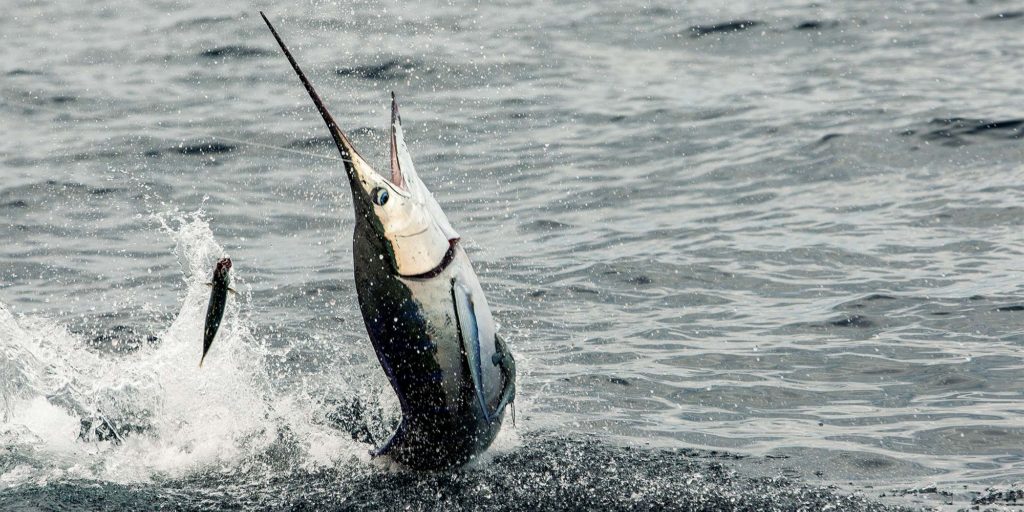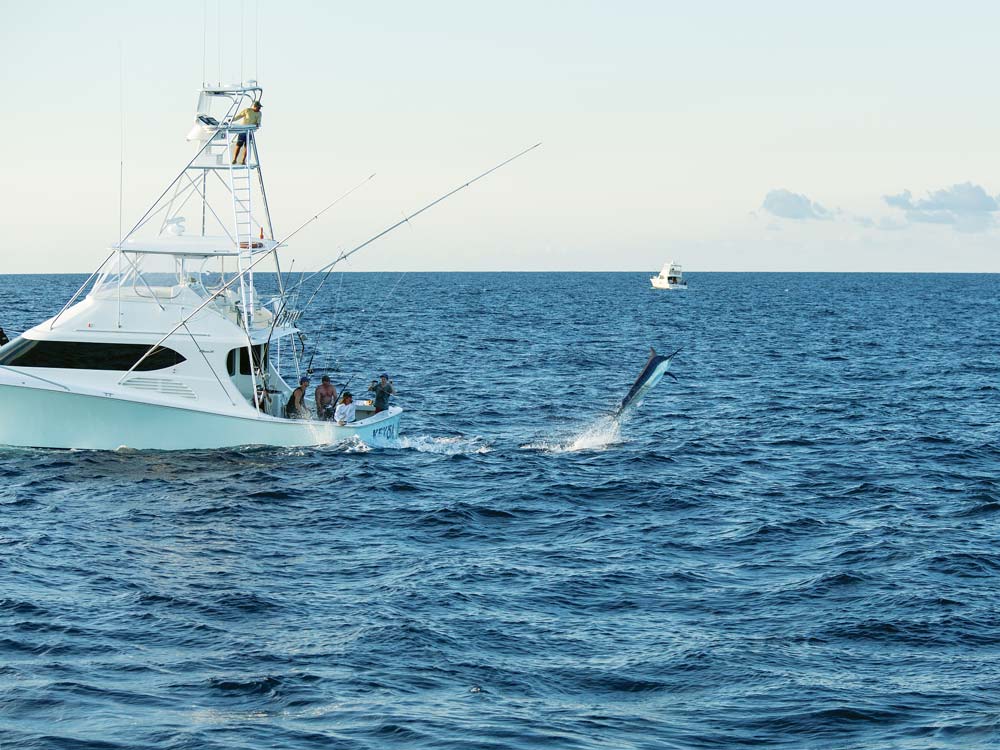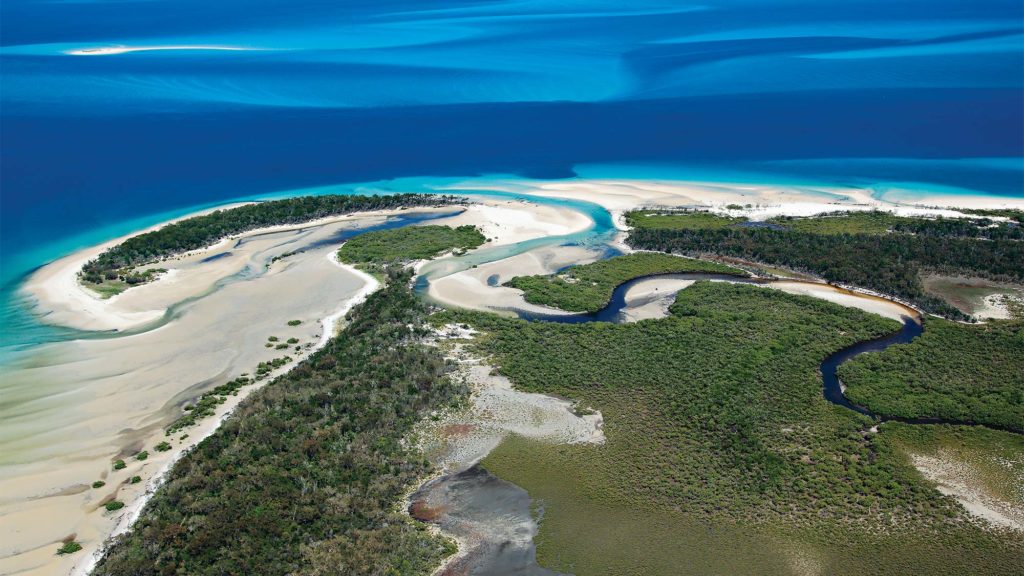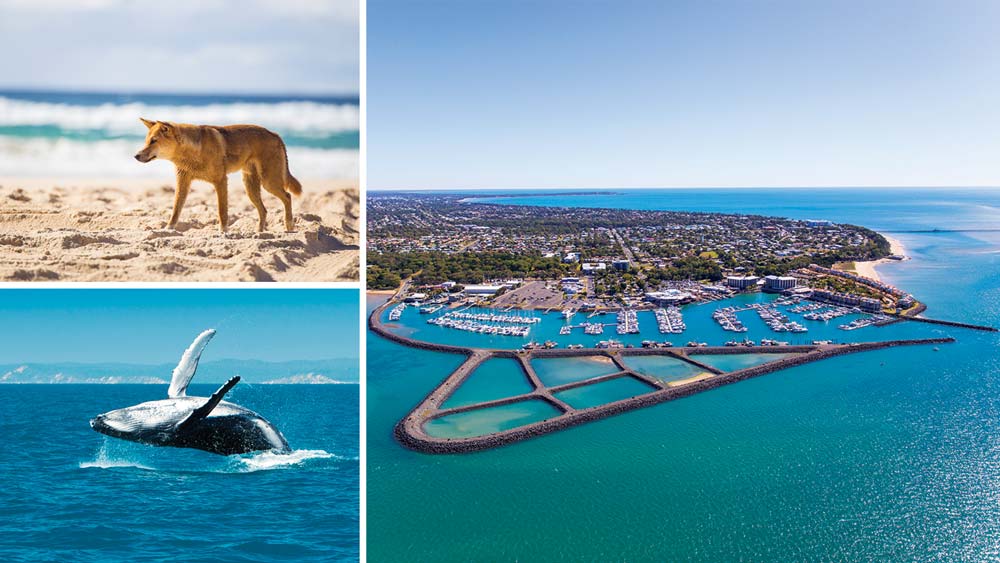
Situated off the southeastern coast of Queensland, Australia, is one of the world’s most unique, diverse and beautiful destinations: Fraser Island. Said to be the largest sand island in the world, its natural beauty and cultural heritage are beyond belief. Uninterrupted snow-white beaches flank stunning tree-lined hills, while towering cliffs protect the inland’s freshwater creeks, swamps and lagoons.

A number of ancient rainforests are scattered throughout the island, and it’s one of the only places in the world where these lush forests actually grow along sand dunes. Due in part to this incredible biodiversity, Fraser Island was listed as a UNESCO World Heritage Site in 1992.
Blacks on the Flats
The waters around Fraser Island teem with myriad fish species. On my first visit, I participated in one of the popular Toyota Fishing Classic tournaments, where I completely lost count of the different species we caught.

One amazing Fraser Island fishery is for the juvenile black marlin as they migrate down the eastern coast. Good numbers of these small marlin also hang around in the summer months, feeding in the bait-rich waters of Hervey Bay, located on the western side of Fraser. Plenty are caught just off the beach in the gin-clear currents along the sandy flats and channels in one of the world’s most unique marlin fisheries.
Anglers target these feisty billfish by sight-casting and trolling from small outboard vessels and even kayaks. Saltwater fly-fishing is also popular and very productive. Because of the shallow depths, the small blacks are the perfect target for light spinning tackle, and the fish usually remain within view of the angler for most of the fight. It’s an unforgettable sight to witness.

Heavy-Tackle Marlin Fishing
There is another wild and exciting side to fishing at Fraser Island that has hit an entirely new level. In recent years, anglers have targeted the larger black, blue and striped marlin population, as well as sailfish, and we have found all four species remain in these waters around Fraser Island for most of the year. Anglers familiar with this region have known for decades these fertile grounds of the southern Coral Sea are regarded as a spawning area for striped marlin. For many years, commercial longline fishermen have been working the area, and their catch rates have always been disturbing.
The highly regarded Coral Sea Region Billfish Atlas, released in the 1980s by the Australian Institute of Marine Science in Townsville, noted even back then the incredible catch rates from this area, particularly during the months of October, November and December. Not only were large numbers of striped marlin caught here commercially, but blue marlin as well.
The potential for billfish in this region has also been well-known by the sport-fishing fleets on Australia’s east coast for many years. The amount of marlin hooked through this remote region by the New South Wales and southern Queensland professional charter fleet, heading to or from its annual heavy-tackle black marlin seasons up the coast in Cairns, has always been phenomenal.

These vessels are usually conserving fuel during the long trip either to or from the fishing grounds and travel at an economical trolling speed around 8 to 10 knots, nearly always with a spread of lures in tow. What has become known as the Marlin Highway — from Fraser Island to Lady Musgrave Island a hundred miles to the north — consistently produces hookups galore.
“And it’s not only big blues and striped marlin that are hooked here, but plenty of black marlin as well.”
And it’s not only big blues and striped marlin that are hooked here, but plenty of black marlin as well. In 2017, the charter vessel Tradition was returning home from Cairns to the Gold Coast when a grander black marlin jumped on one of its lures. There just so happened to be a mothership in the area that was also returning to the Gold Coast from Cairns, and it was able to weigh the 1,054-pound beast for Capt. Tim Richardson.
Another charter boat from the Gold Coast that has made the journey to and from Cairns for decades is Ice Man, skippered by Capt. Bobby Jones. I fished with Jones for many years, and he has always told me stories about these grounds. “The Fraser Island area is amazing,” he says. “We can troll for over 200 miles north from the Gold Coast and maybe get one bite on a lure. As soon as we get on the Marlin Highway, the journey gets interrupted all the time. Between Fraser and Lady Musgrave, the strikes from striped marlin and solid blues just keep on happening. We released a blue there a couple of seasons ago that was every bit of 850 pounds, and we’ve had bigger ones on.”
Other Gold Coast skippers, such as Viking II‘s Capt. Billy Bilson and Capt. Ross McCubbin, who runs Lucky Strike, have similar stories of the constant action through this area. Father-and-son captains Barry and Brett Alty, on Mistress, said to me many years ago they wished they spent more time on these Fraser grounds. “It’s always action stations for us when we’re traveling north to Cairns on our well-worn GPS track between Fraser and Lady Musgrave Island,” they report. “Coming back home from Cairns in late November is even better, and the blue marlin action in particular is phenomenal.”

The Fraser Island Challenge
So finally, after many years of knowing about the incredible potential of this remote area, a couple of vessels from the Gold Coast have been spending time exploring the deep continental shelf grounds off Fraser. Mistress in particular has now spent a few years there, and in 2016, the Altys won the popular Hervey Bay Game Fishing Club’s annual marlin tournament. Forty-four boats fished the tournament, and plenty of billfish were tagged and released, but no one could catch the Mistress team, with eight solid blues up to 600 pounds released in two and a half days of fishing.
In 2017, during spring and early summer (August to December in Australia), the Altys decided not to go to Cairns, but instead work the Fraser Island grounds. At this point in time, we don’t know how long the season might be, but their results have been absolutely fabulous. “We fished a total of 44 days before Christmas and recorded 94 blues, 20 blacks and seven striped marlin,” says Capt. Barry Alty. “We left the boat at Hervey Bay and flew in and out from the Gold Coast whenever we had a charter or just felt like taking some friends out for a fish. The constant action really hasn’t surprised us.
“Many of the blues have been in the 200- to 600-pound range, and they’re a great size for anyone looking at catching records on lighter tackle,” he continues. “We stuck to our game plan last year and used heavy 130-pound-class tackle because we have always had the feeling a grander blue would be lurking somewhere on these fishy grounds. We were right.
“Among the blues raised, we hooked two that were well over the grander mark, and we know what a 1,000-pound marlin looks like from all our years of catching granders in Cairns,” Barry says. “We were really hoping to catch Australia’s first official 1,000-pound blue off Fraser, but of course, that happened over in Exmouth, Western Australia.” The new year was just a few days old when Capt. Eddy Lawler and Clay Hilbert landed Australia’s first blue marlin over 1,000 pounds in January 2018. Their fish weighed 1,089 pounds.

Tackle and Techniques
I asked these two captains what they are doing to contribute to hooking and tagging so many blue marlin.
“We’ve changed lures and also the hooks in recent years,” Barry says. “We’re raising more marlin than ever on the Aussie-made Tornado lures. They are really well-balanced and run nicely in any position in the spread we put them. The secret to these lures is in the head. If you put an unrigged Tornado on a table, it will roll over to the way it should run through the water.
“We also switched over to Black Bart Pa’a hooks, and they are setting far better than any other brands we have tried. We realize you’re never going to stay connected to every marlin you hook, but these hooks go in and rarely come out. Our strike-to-catch rate at the moment on blues is an amazing 85 percent.”
The next challenge for the Altys: break a few Australian line-class records on blue marlin. “The current 12- to 50-pound records are within range here, especially on our fast-maneuvering 50-foot Mistress,” Barry says. This Kiwi-built vessel is ideal for these waters on any tackle, and it’s also big enough to live aboard should they decide to stay at the top of Fraser Island when the weather is suitable. Staying aboard gives the team even more fishing time.
Another Player on the Scene
Capt. Bobby Jones, fishing aboard Merlin, his new 65-foot Mariner, has also been spending time at Fraser Island. Jones recently retired from charter fishing out of Cairns after four decades and now just wants to spend more time on these exciting grounds, which are much closer to his home on the Gold Coast. Last year, he took Merlin up to Hervey Bay to finally check it all out.
“There’s no doubt about it, the billfishing is outstanding out wide of the island in around 100 fathoms and even deeper,” he reports. “The interesting thing is the season could be a lot longer than we first thought. It could almost be a year-round fishery for billfish, but only time will tell. The logistics of targeting the big marlin out wide on the continental shelf is the only problem we face. It can be a little challenging because of the distance we have to run from Hervey Bay. It’s a good 60-mile journey to the grounds, and of course, the weather will determine how long that will take.”
Jones says that when the weather is kind, they can use the anchorage at Waddy Point at the top of Fraser Island. Staying there overnight cuts down the traveling time to the shelf considerably, and they only have to run about 8 miles before they can start trolling in fishy water. “It certainly would be great if this anchorage was better and we could use it all the time, but if the seas are up, the swells push around the point and roll the boat all night,” he says.
The beauty of Fraser Island and Hervey Bay, though, is there’s a lot to do if the weather stops you from going out wide for the big marlin. Depending on the time of year, the little blacks can be chased near the island. There is also plenty of light-tackle fishing in Hervey Bay itself, where you can not only have some great fun but also a superb catch of fresh fish for dinner.

Light-Tackle Potential
Another Cairns-based vessel that visited Fraser Island last year, the 56-foot Kekoa, skippered by Capt. Luke Fallon, also found amazing fishing. Normally, Fallon works a full Cairns season right until the end of November, but the draw card of so many potential record-size marlin off Fraser made his decision to move south a positive one. On board was American light-tackle master Gary Carter, who was determined to break records on all three marlin species.
Carter had a ball, with dozens of shots every day switch-baiting, and the tough, speedy blues in particular kept him busy on 8-pound-test tackle, with long, tough fights. Unfortunately, all the blues he hooked eluded capture, and many were potential Australian and even world records. He came away with a pending Australian 2-pound-test record on black marlin and experienced some good battles with the area’s striped marlin population as well. After Carter departed and the light tackle rested a bit, Kekoa released 25 blues, three blacks and two striped marlin in a seven-day stretch. That’s great fishing anywhere in the world, but it’s just another week in Fraser Island.

Get to Know Fraser Island
By Air
International flights arrive into either Sydney or Brisbane, Australia, where direct flights are then available to the airport at Hervey Bay. Plenty of taxis and shuttle buses are available to the hotels and resorts just a few miles away.
Accomodations
There are plenty of nice accommodations near the marina, including the Mantra Hotel and the Great Sandy Straits Break Free apartments. All have uninterrupted views of beautiful Hervey Bay. There are a number of small, secluded and very pretty beaches close by as well.
The Great Sandy Straits Mariner, located on the northern end of Urangan Harbour in Hervey Bay, is where most of the sport-fishing and whale-watching vessels work. This modern marina has 180 berths and is suitable for vessels up to 150 feet in length. There are great facilities, including hotels, resorts, clubs, restaurants and cafes, close by, many within walking distance.
Billfish Season
The more we fish this incredible area, the more we believe it is probably a year-round fishery for marlin and sailfish. The warm Coral Sea currents push through the area most of the year; in the cooler winter months, when the more temperate currents move in, the temperature range remains comfortable for all four billfish species found here, and especially striped marlin. At this point, the late spring and early summer months from August to December in Australia are definitely the red-hot period.
Charter Boats
Whale-Watching
Hervey Bay has become Australia’s premier whale-watching destination, and a number of charter vessels cover the season between July and November. The operators get close to the action, and they guarantee you will see a few whales or maybe even an entire pod as they migrate along the coast.







